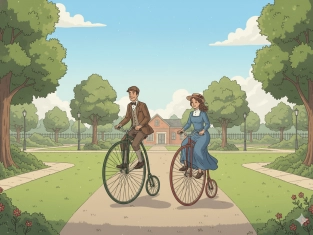Past Simple vs Past Perfect
Table of Contents
Exercises
Explanation
Understanding the difference allows you to tell stories more clearly and avoid confusion about time order.
1. Past Simple – Form and Use
Form
-
Affirmative: subject + V2
-
Negative: subject + did not (didn’t) + V1
-
Questions: Did + subject + V1?
We use the Past Simple for:
-
actions that happened once or repeatedly in the past,
-
actions that are fully completed,
-
events with a clear time reference.
Examples
-
She bought a new jacket last Friday.
-
We didn’t stop at the café yesterday.
-
Did you enjoy the concert last night?
Typical time markers
yesterday, last week, in 2010, a moment ago, two days ago, last night
2. Past Perfect - Form and Use
Form
-
Affirmative: subject + had + V3
-
Negative: subject + had not (hadn’t) + V3
-
Questions: Had + subject + V3?
We use the Past Perfect to show:
-
the earlier of two past actions,
-
the background or cause of another past event,
-
experiences completed before a specific time in the past.
It makes the sequence of events clear.
Examples
-
I had locked the door before anyone arrived.
-
They hadn’t finished the report when the manager asked for it.
-
Had she studied Spanish before she moved to Madrid?
Common time markers
before, after, already, just, by the time, previously, earlier, by then
3. Comparing the Two Tenses
Key Differences
|
Feature |
Past Simple |
Past Perfect |
|
Meaning |
A completed past action |
An action completed before another past action |
|
Form |
V2 / didn’t + V1 / Did + V1 |
had + V3 / hadn’t + V3 / Had + V3 |
|
Typical markers |
yesterday, last year, ago |
before, already, by the time, after |
|
Example |
I found my wallet. |
I had found my wallet before I left the house. |
More Examples
-
Past Simple: Leah missed the bus.
-
Past Perfect: Leah had forgotten her ticket, so she missed the bus.
-
Past Simple: He sent the email.
-
Past Perfect: He had written it earlier in the morning.
4. How to Choose: Past Simple or Past Perfect?
A simple decision method:
-
Are there two actions in the past?
-
Did one action happen earlier than the other?
If yes:
-
Earlier action → Past Perfect
-
Later action → Past Simple
Example
When we reached the beach, the sun had already set.
→ The sun set first; we arrived second.
5. Can Past Perfect be used alone?
Yes. We can use Past Perfect without a second action if the earlier event is understood from the context.
Examples
-
She was relaxed because she had taken the afternoon off.
-
He was nervous because he had never spoken in public before.
In short:
-
Use the Past Simple for finished past actions.
-
Use the Past Perfect when you need to show which past action happened first.
These two tenses work together to help you describe past events clearly and logically.

